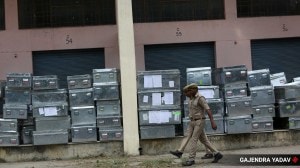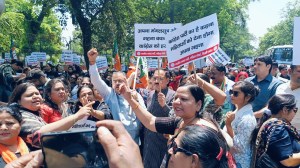- India
- International
Saving Maharashtra’s public library culture
The Maharashtra government recently announced a scheme to start a ‘Village of books’ in each district to ‘nurture reading culture in today’s time’. At the same time, public libraries are struggling to survive amid fund cuts and changing reading habits among people. Maharashtra has witnessed the closure of over 712 public libraries over the last decade. PALLAVI SMART takes a close look at the crisis and steps that need to be taken to address the issue.
 Chembur Public Library in Mumbai. (Express photo by Pradip Das)
Chembur Public Library in Mumbai. (Express photo by Pradip Das)A Librarian at the Chinchpokli Public Library for the last 15 years, Samata Nagwekar fondly recalls the time when her workplace used to swarm with book lovers of all ages and socio-economic groups. Not anymore. Thanks to a number of factors, including the Covid-19 pandemic, Nagwekar’s work day now looks very different from what it did a decade-and-a-half ago. “Already our membership comes from the above-40 age group, with highest numbers coming in from senior citizens wanting to read novels. A significant number of them had stopped visiting libraries or exchange of books due to the fear of Covid-19 infection. Now, as we walk toward normalcy, we have not seen all of them returning to libraries. Many have found alternatives for their habit of reading,” said Nagwekar.
She is not the only one. Public libraries in the state have been in dire straits for a while now and the staff working there a first-hand witness to their decline. In 2012, Maharashtra had 12,861 registered public libraries. Over the last decade, more than 712 of these libraries have shut down due to various reasons, including lack of funding and resources.
Buy Now | Our best subscription plan now has a special price
Under such circumstances, the state government’s recent announcement of setting up a “Village of Books” in each district has left many asking how the authorities plan to go about their motive to “nurture reading culture in today’s time” when little is being done to bring several already existing libraries back from the verge of closure.
How Public Libraries Function in State
A bulk of Maharashtra’s public libraries are run by private trusts, which are government recognised and thus entitled to a certain amount of grant from the Directorate of Libraries as per their grade defined through specific parameters. There are a total of four grades – A, B, C, and D for such libraries. The grades are decided based on certain parameters explained by the government such as number of books, periodicals, magazines and newspapers available, total cost of the reading material available, number of members and whether the premises is rented or owned by those running the library. Besides, libraries falling under A and B category also have to provide certain services such as holding cultural events for the local community and providing separate section for children and women. Prior to 2013, libraries had the chance to improve their condition and apply for higher gradation, which meant more grant.

 Public libraries in the state have been in dire straits for a while now and the staff working there a first-hand witness to their decline. (Express photo)
Public libraries in the state have been in dire straits for a while now and the staff working there a first-hand witness to their decline. (Express photo)
This system of funding was decided in 1995 and last reviewed in 1998. Since then, there has been no review in the state on how libraries will be funded. In 2013, the Maharashtra government passed an order stating that no new library should be given permissions and ordered a stop on the process of upgradation of libraries. During an audit of all government recognised public libraries by the revenue department after a proposal to increase their grants, many were found not complying with the stipulated parameters. The Directorate of Libraries ordered cancellation of approval of 914 such premises. The state government was expected to frame a new policy for these public libraries post the audit and it was decided that no new approval will be issued until that is done. However, seven years on and two committees later, there has been no development on that front.
A Sorry State of Affairs
Libraries under the category of A, B, C and D get government grant of Rs 2,88,000, Rs 1,92,000, Rs 96,000 and Rs 30,000 per year, respectively. “It is expected that they spend half of the amount on salaries of the staff and remaining half on the enhancement of the library,” said Dilip Kore, Director, Maharashtra State Library Association, adding that most are on the verge of closing due to lack of funds.
 A bulk of Maharashtra’s public libraries are run by private trusts, which are government recognised and thus entitled to a certain amount of grant from the Directorate of Libraries as per their grade defined through specific parameters. (Express photo by Pradip Das)
A bulk of Maharashtra’s public libraries are run by private trusts, which are government recognised and thus entitled to a certain amount of grant from the Directorate of Libraries as per their grade defined through specific parameters. (Express photo by Pradip Das)
According to the trusts running the libraries, every year is a struggle to acquire government grant as the installments are always delayed due to fund deficit. In 2021-22, an amount of Rs 122.51 crore was allotted for government-recognised public libraries. It has been reduced to Rs 112.51 crore in the recently approved budget for the year 2022-23. “This deficit in the budgetary allocation clearly means another shortfall of funds when we are already waiting to receive Rs 21.41 crore from the previous financial year’s allocation. This is very dangerous for the government-recognised library culture in Maharashtra,” said Kore. He said that most trusts running libraries are “bleeding” now, especially after the pandemic when there was no means of revenue generation with members staying away.
The association also held a protest at Azad Maidan in March, which saw libraries from across the state participating in the stir. Following the protest, their issues — starting from meagre salaries to deficit in budget –were raised in the assembly by a few representatives during the budget session. “However, the government has failed to provide any satisfactory explanation or future planning. It is like the government is waiting for these libraries to pull down the curtains on their own. Whereas, a new initiative has been announced where the state government plans to start a ‘village of books’ per district with Rs 50 lakh funding,” said Kailash Jadhav from Udhava Public Library in Palghar district.
Illustrating his point of “complete apathy of the administration” towards libraries, Jadhav said, “Palghar was declared as a separate district in 2014. But according to the Directorate of Libraries, it is still under Thane district because the required paper work is pending. It is a different struggle for libraries in Palghar district to ensure that their issues are heard.”
It was almost two decades ago when these libraries were last given any attention by the state government following which a committee was formed to provide recommendations to enhance the services in the state. But that report was never presented while the libraries continued their struggle. Lack of funds was already a problem for government-recognised public libraries to begin with, but a complete lack of policy and advocacy has led to their slow death with the pandemic only making the situation worse, according to the librarians.
The Pandemic Effect
Even with insufficient funds, the libraries continued to run pre-Covid as the trusts employed their own ways to earn revenue. Small as they may be, the measures ensured steady financial support. One of them was membership fees — one of the most straightforward earning models for libraries. Some rented their premises out, others held workshops and study circles. But Covid put a stop to all of that. According to data accessed by The Indian Express, the membership figure, which was 2033406 in 2019-20, dropped to 1881565 in 2020-21 in the state. Apart from reading, these libraries were considered good spots to find old periodicals, magazines, newspapers, reference books and other academic literature which led several researchers to their premises. But lately, even those numbers have dropped from 805088 in 2019-20 to 561929 in 2020-21 even as the number of books in the libraries has increased from 66679295 to 98713810.
 (L-R) Alka Patil, Dilip Kore and Maya Taware; (above) during the librarians’ stir in Mumbai. (Express photo)
(L-R) Alka Patil, Dilip Kore and Maya Taware; (above) during the librarians’ stir in Mumbai. (Express photo)
Nagwekar, the librarian at Chinchpokli, rues how “nobody wants to work for these libraries now.” “My own daughter talks about how she would prefer doing 100 other things over taking up a job in a government recognised-library for a meagre salary,” said Nagwekar, adding that with the rate things are going, “there will be no one working for these libraries”.
Meagre Pay
As per the specified criterion of six hours of work every day, librarians from each of the categories draws a minimum salary of Rs 3,000, Rs 2,600, Rs 2,000 and Rs 1,250 a month, respectively. For clerks and peons, the pay is lower than this. Salaries drawn by staff working at these libraries are far less than minimum wage prescribed by the Maharashtra government, many point out. Jayashree Devkar, who works as a librarian at the Vidyarthi Utkarsha Mandal’s Samartha Granthalay in Chinchpokhli, says she always “hides her salary” from others. “The profile offers respect in the society. But the financial rewards are measly,” she said. Jananrdan Bhoye who works at the Udhava Public Library in Palghar district says, “What was the point in me doing a course to work in the library?”
A Vicious Circle
People in the know of the matter say it is all a vicious circle: Government apathy has led to lack of funds which has resulted in restriction in services provided by the public libraries due to which they are unable to meet current market standards, including hiring of new staff members. All this has led to constant reduction in the number of readers, especially children.
“But books are still getting published. People have not stopped writing and reading. Only the format of consumption has changed. And unfortunately, our government-recognised public libraries are not equipped to sail through this transition,” said a committee member of a library in Mumbai, adding that the apathy is not just on the part of the government but also the trusts which are running the libraries.
According to him, most are just depending on government grants, without taking additional efforts to ensure meeting new market standards. “Only recently, the directorate asked these libraries to open social media accounts. Many did not, citing fund issues. We need to evolve with changing times to survive,” said the official, requesting anonymity.
But according to most libraries, bringing about these changes is impossible without financial and policy driven guidance from the government in order to preserve the public library culture. The government has failed to form any policy for libraries, they said, pointing out that even in today’s world of digitalisation, these libraries are keeping manual records. Besides, there are no books to attract the young generation as the focus remains on Marathi literature. The number of members in the children’s section is dropping constantly with many students studying in English-medium schools and libraries only having Marathi books to offer.
Getting On With the Times
While most libraries are pointing at lack of funds, Alka Patil from Jaihind Library in Vasai is setting up an example of sorts. After keeping the library open for three hours each in morning and evening — as per the mandated schedule — Patil moves around the town in the afternoon to deliver and collect books from members at their doorsteps. “Today, when most services are available at their finger tips, expecting that our members will come to the library seemed a bit ambitious. This service actually started in pandemic as members started connecting with me on WhatsApp when the library was closed. But now many have gotten used to the new practice,” said Patil, adding that she could get the “system” to work wonders only if she had a helping hand to share her daily work load with. Maya Tawade from the Chembur Public Library said her library has added books from South Indian and English languages in their stock considering preferences of a few local residents.
“Number of children is reducing drastically at the library. There was a time when we had more than 100 children as members, which would increase during vacation period. But now those are restricted to only 20-25,” said Tawade, who has been working as a librarian for almost 36 years now.
Nagwekar’s library in Chinchpokli is associated with a local youth initiative, which keeps the shared premises alive with many events. “One can witness newer ways developed by these youngsters to generate funds in order to keep the trust running. While it helps the library in many ways, this clearly highlights the requirement of a young approach in functioning of libraries to attract the young generation. But nobody wants to work for these libraries now,” she said.
Plan of Action by the Authorities
Realising the issues faced by the libraries and the overall impact on the reading culture in the young generation, the Directorate of Libraries is working on a plan of action to improve the situation.
“Digitalisation will be the focus along with attractive measures to suit the young generation of changing times. Apart from starting a web portal and keeping digital records and digital books, the directorate plans to connect with schools. The idea is to have each of our recognised public libraries connect with local civic and other government schools to provide books for reading to children. This will not only help inculcate reading habits in them, the libraries too will have newer, younger members. We also plan to start ‘books on wheels’ to go in areas where there are no libraries in the periphery, especially rural and tribal areas,” said Shalini Ingole, director.
A government resolution (GR) was issued in June 2021 on formation of a committee, which will design a plan of action for digitisation of libraries. Interestingly though, a similar GR was issued in March 2017 along with formation of committee. But it did not yield any results.
According to government officials, considering that this is not a revenue generating department, libraries have always been pushed back on the priority list. As a result, libraries are left struggling for funds. This brings one back to the original question: How does the government plan on nurturing a reading culture when local libraries are on the verge of shutting shop?
Apr 24: Latest News
- 01
- 02
- 03
- 04
- 05







































